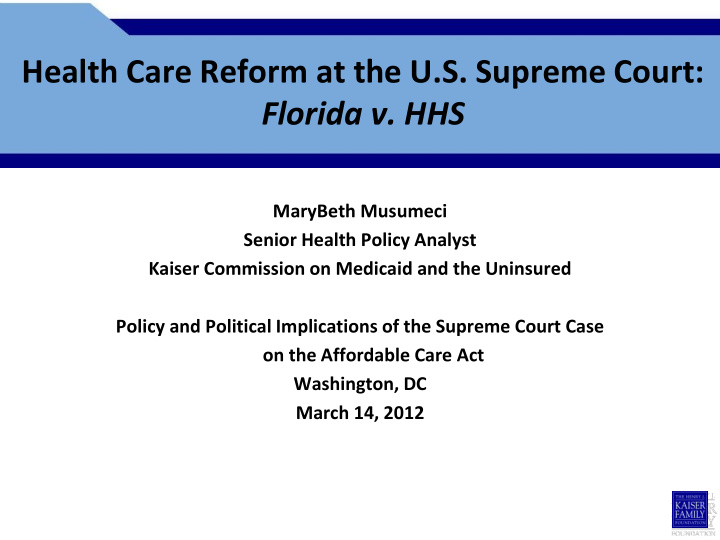



Health Care Reform at the U.S. Supreme Court: Florida v. HHS MaryBeth Musumeci Senior Health Policy Analyst Kaiser Commission on Medicaid and the Uninsured Policy and Political Implications of the Supreme Court Case on the Affordable Care Act Washington, DC March 14, 2012
FIGURE 1 Parties 26 States, led by Florida U.S. Departments of Health & Human Services, and vs. Treasury and Labor NFIB and Individual Plaintiffs
FIGURE 2 Key Dates March, January, Supreme 2010: August, 2012: Court ACA 2011: Supreme decision 11 th enacted Court expected and Fl. v. Circuit briefing by June, HHS filed decision begins 2012 January, November, March, 2012: 2011: 2011: Supreme Fl. district Supreme Court oral court Court arguments decision accepts case
FIGURE 3 The Road to the Supreme Court Fl. v. HHS accepted by the Supreme Court Decisions from 7 federal appeals courts: 1 struck down mandate, 6 did not At least 26 cases filed in federal district courts: 2 struck down mandate, 24 have not
FIGURE 4 States’ Positions in FL. v. HHS VT WA ME MT ND NH MN MA NY OR WI SD ID MI RI CT WY PA NJ IA NE OH DE IN IL NV MD UT WV VA DC CO KS MO KY CA NC TN SC OK AR AZ NM GA AL MS LA TX FL AK HI States challenging the ACA (25 states) States both challenging and supporting the ACA (2 states) States supporting the ACA (11 states) States not taking a position in the litigation (12 states) Note: VA filed its own challenge separately and is not a party in the case accepted by the Supreme Court
FIGURE 5 Issues 1.Do courts have jurisdiction to decide the constitutionality of the ACA’s individual mandate provision now? 2. If so, is the ACA’s individual mandate provision constitutional? 3.If unconstitutional, is the individual mandate provision severable? 4. Is the ACA’s Medicaid expansion constitutional?
FIGURE 6 Issue 1: Anti-Injunction Act (AIA) • If the Court decides that the ACA’s financial penalty is considered a “tax” under the AIA, this challenge to the mandate is dismissed, and courts cannot hear cases about the whether the mandate is constitutional until April, 2015 . • If the Court decides that the AIA does not apply, the Court will decide whether the mandate is constitutional now .
FIGURE 7 Issue 2: Constitutionality of the Mandate • Possible Bases for Constitutionality: -Commerce Clause -Necessary and Proper Clause -Tax Clause • If the Court decides the mandate is constitutional, it will take effect in 2014, unless Congress acts to repeal or postpone it.
FIGURE 8 Issue 3: Mandate is Struck Down – Is it Severable? • If the Court decides the mandate is not severable from the rest of the law, it invalidates the entire ACA . • If the Court decides the mandate is severable , the Court could -strike just the mandate, or -the Court could also strike the guaranteed issue and community rating provisions .
FIGURE 9 Issue 4: Medicaid Expansion Upheld If the Court decides the Medicaid expansion is constitutional, it takes effect in 2014, unless Congress acts to postpone or repeal it.
FIGURE 10 Issue 4: Medicaid Expansion Struck Down • If the Court decides the Medicaid expansion is not severable , it invalidates the entire ACA . • If the Court decides the Medicaid expansion is severable , the Court could: -strike just the Medicaid expansion, or -strike the Medicaid expansion and other provisions of the ACA.
FIGURE 11 What’s At Stake for Health Care Reform in the Supreme Court? • Individual Mandate • Medicaid Eligibility Expansion • Entire ACA, including: – Health insurance market reforms – Health insurance exchanges – Employer responsibility provisions – Tax subsidies for premiums and cost-sharing – Medicare benefits expansion, payment reductions – Delivery system reforms (ACOs, etc.) – Public Health and Prevention Fund – Health care workforce expansions – Transparency and program integrity provisions
Recommend
More recommend